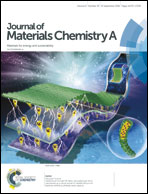An ultrasensitive NO2 gas sensor based on a hierarchical Cu2O/CuO mesocrystal nanoflower†
Abstract
Hierarchical Cu2O/CuO mesocrystals have been fabricated by a one-step, controllable and low-power method. A novel “Etch-Oriented Self-Assembly” growth mechanism is proposed to describe the formation of hierarchical Cu2O/CuO mesocrystals. In an alkaline environment, Cu2O nanoparticles are generated first; they are then etched into small sized (14–18 nm) CuO nanocrystals which assemble in an oriented way to form Cu2O/CuO mesocrystal nano-petals. As the reaction progresses, the obtained nano-petals stagger together to construct a hierarchical nanoflower structure. All factors that may influence the morphology of the final product have been investigated. The sensing results indicate that the product at 10 h exhibits the highest sensitivity to NO2 (73 162 to 10 ppm) at room temperature. Even when the concentration of NO2 drops down to 1 ppb, the sensing response of the Cu2O/CuO-10 mesocrystals can reach 13.5. In addition, the sensor's response speed is ultra-fast and its response can increase to 2658 in 2 s when exposed to 10 ppm NO2 and recover 96% within 200 s. To study the sensor's response mechanism, the influence of pre-absorption of H2O has been studied by experiments as well as the first-principles calculations, and a rational mechanism has been put forward to explain its distinctive sensing performance.



 Please wait while we load your content...
Please wait while we load your content...